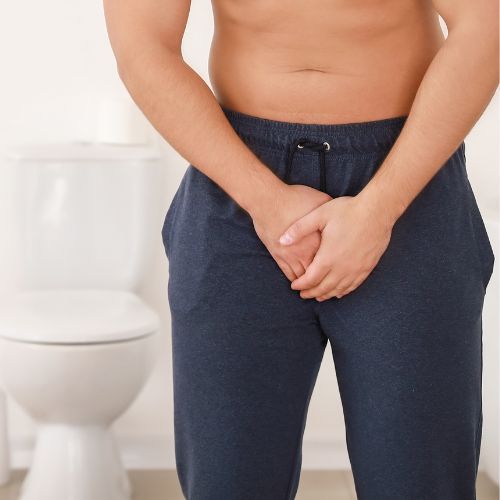By Kylie Conway
•
August 27, 2025
Male Pelvic Pain: Understanding the Many Faces of Discomfort Pelvic pain in men is a complex issue involving various muscles, nerves, organs, and psychological factors. Since the pelvic region houses key structures such as the bladder, prostate, urethra, bowel, and the pelvic floor muscles, pain may present differently depending on the underlying cause. Recognising the specific types of pelvic pain and related symptoms can help men seek appropriate care early and improve outcomes. Common Types and Examples of Male Pelvic Pain Prostatitis and Chronic Pelvic Pain Syndrome (CPPS) Pain Types: Dull aching in the lower abdomen, sharp stabbing pain in the perineum (the area between the scrotum and anus), burning during urination, and discomfort after ejaculation. Additional Symptoms: Urinary frequency and urgency, weak or interrupted urine stream, and sometimes flu-like symptoms in bacterial prostatitis. CPPS, a non-bacterial form, often features muscle tightness and nerve irritation causing persistent discomfort without infection. Pelvic Floor Muscle Tension and Spasms Pain Types: Intermittent or constant burning sensation deep in the pelvis, a "stuck" feeling during urination, testicular or penile pain not explained by infection. Often worsened by sitting for long periods, sexual activity, or stress. May also cause referred pain to the lower back, hips, or thighs. Pudendal Neuralgia (Nerve Entrapment) Pain Types: Sharp, burning, or electric shock-like pain primarily localised to the perineum and genital area. Pain often worsens when sitting on hard surfaces and improves when standing or lying down. May include numbness, tingling, or altered sensation around the genitals and anus. Urethral Pain Syndrome and Urethritis (Non-infective) Pain Types: Burning or raw sensation at the urethral opening, pain with urination, or persistent pelvic discomfort. This can happen without bacterial infection and is sometimes related to pelvic floor dysfunction or inflammation. Testicular Pain and Epididymitis Pain Types: Sharp or aching pain localised to one or both testicles, sometimes radiating to the groin or lower abdomen. May be associated with swelling, tenderness, or warmth. Causes include infection, trauma, or referred pain from pelvic floor muscles. Bladder Pain Syndrome / Interstitial Cystitis Pain Types: Persistent pressure, discomfort, or burning in the bladder and perineal region. Symptoms often worsen with bladder filling and improve after urination. May be accompanied by urinary urgency and frequency. Hernia-Related Pelvic Pain Pain Types: Dull aching or sharp pain in the lower abdomen, groin, or pelvic area, especially when coughing, lifting, or standing. Often associated with a noticeable bulge or lump in the groin. Irritable Bowel Syndrome (IBS) and Gastrointestinal Pain Pain Types: Cramping, bloating, and lower abdominal discomfort that can refer to pelvic areas. May be associated with bowel changes such as diarrhea or constipation. Bowel problems often coexist with pelvic floor dysfunction, complicating pain presentation. Musculoskeletal Pelvic Pain Pain Types: Aching or sharp pain stemming from muscles, ligaments, or joints of the pelvis and lower back. Causes include poor posture, pelvic instability, trauma, or overuse injuries. Pain may radiate into the groin, perineum, or thighs and can worsen with sitting, standing, or movement. Sexual Dysfunction-Related Pelvic Pain Pain Types: Pain during or after ejaculation, penile or perineal burning, and pain associated with erectile dysfunction. Often linked with pelvic floor muscle tension or nerve irritation. When to Seek Help Men experiencing any of the following should consult a pelvic health physiotherapist or healthcare provider: Persistent or worsening pelvic, perineal, testicular, or genital pain Pain worsened by urination, ejaculation, sexual activity, bowel movements, or sitting Difficulty starting or maintaining urine flow, weak or split stream Urinary urgency, frequency, dribbling, or incontinence Numbness, tingling, or unusual sensations in the pelvic or genital area Visible lumps, swelling, or signs of infection (fever, chills, burning urination) How Pelvic Floor Physiotherapy Can Help Pelvic floor physiotherapists specialize in diagnosing and treating pelvic pain related to muscle dysfunction, nerve entrapment, and biomechanical issues. They use techniques such as: Manual therapy to release muscle tension and trigger points Tailored exercises to strengthen or relax pelvic muscles Education on bladder, bowel, and posture habits Neuromodulation techniques like TENS or biofeedback Collaborative care with urologists, gastroenterologists, and pain specialists Early assessment and intervention can greatly improve pain relief, bladder and sexual function, and quality of life. Expert Tips for Managing Pelvic Pain at Home Maintain regular bowel habits to prevent constipation and straining Practice relaxation techniques and mindfulness to reduce pelvic muscle tension Avoid prolonged sitting or pressure on the perineum; use cushions and take breaks Stay hydrated and avoid bladder irritants like caffeine and alcohol Use warm baths or heat packs to relax muscles and improve circulation Engage in gentle stretching and low-impact exercise as advised by your physiotherapist At Pelvic Health Melbourne, all our physiotherapists are trained to help manage all types of pelvic pain men encounter. You don’t have to live with pelvic pain—help is available.












